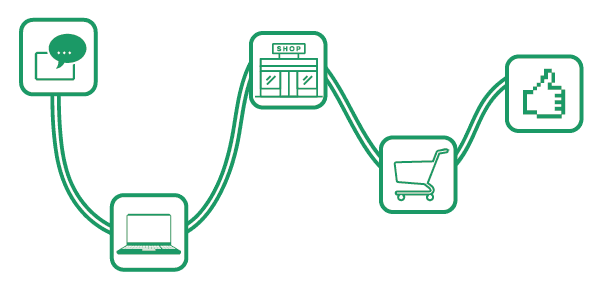Customer Journey Optimisation and How it Defines the Future of Business
By Team Arrk |
|
5 mins read |

Customer Journey Optimisation is a term applied to online retail. It’s popular with ecommerce businesses, and bricks-and-mortar companies who have adapted their models to sell products online.
The rapid spread of the internet from the late nineties onwards has led to a huge growth in ecommerce, with most businesses having no choice but to stay competitive by offering online sales. The rise of mobile has exacerbated this trend, with many customers expecting to buy products online in just a few clicks.
Retail ecommerce sales are expected to exceed $4 trillion by 2020, up from just under $2 trillion in 2016.
Online retail is still such a young industry that companies have only recently been focusing on optimising their online customer journeys. The cost of failing to do so is high. Many familiar high street brands that failed to keep up have gone the way of former electronics retailer Dixons and video-rental service Blockbuster.
Definition of Customer Journey Optimisation
Customer Journey Optimisation is closely related to customer experience. As the marketplace becomes more crowded, with lots of e-tailers selling similar products, the key differentiator is the quality of a company’s customer experience.
Customer Journey Optimisation means:
“The process of connecting and mapping customer interactions, across multiple touchpoints, in order to direct or influence the end-to-end experience.” (Genesys)
It’s the systematic, conscious design of a company’s customer experience to provide the highest level of service. It’s viewing your business from the perspective of your customers to provide intuitive and empathetic points of interactions. It’s making it as easy as possible for your customers to buy from your company, and also making them feel appreciated for their business.
Google calls customer touchpoints ‘micro-moments’. These are significant interactions that your customers have with your brand, when you have the best chance to influence their behaviour.
Google calls customer touchpoints ‘micro-moments’. These are significant interactions that your customers have with your brand, when you have the best chance to influence their behaviour.
In ecommerce, there is no more one-size-fits-all. Customer experiences must be personalised.
Advantages
In the past, some industries have been baffling and difficult to understand for customers at best. At worst, companies have completely neglected their customers, knowing they have no other options. This has been especially prevalent in the IT industry.
With the explosion of e-commerce, the spread of software as a service (SaaS), new tech startups and other competitors, that’s all changing.
As the internet has made it much easier to start a business, Customer Journey Optimisation is receiving increased attention. Customers are benefiting from better services and products, as each new company competes for their attention with a flashier customer experience.
On the surface of it all, optimising the customer journey for a business can seem easy at first. Maybe a company will hire a ‘Head of Customer Happiness’, commission a new website, or simplify their payment page.
Disadvantages
Digging more deeply, there are so many variations and touchpoints possible in the customer journey that it would be better to say customer journeys. Anticipating them all is a mammoth task.
Various types of customer support software exists that enable a business to respond to different customer journeys, but no one has quite cracked the omni-channel experience.
It’s difficult to personalise every interaction with a customer when they might be using a mixture of email, live chat, Twitter, Facebook, or Whatsapp. A customer may be using a variety of devices, from desktop, to mobile, tablet, or other smart device. It’s even more challenging to integrate these digital channels with offline interactions.
It can also be very expensive to optimise for the customer journey. Businesses looking to cut operational costs often sacrifice their customer experience, for example by restricting access to customer support or outsourcing.
Different types of customers also have different expectations. Older customers may be offended if you direct them to a self-service support website. Younger customers may be frustrated and leave if you don’t have one.
Personalisation versus privacy
An ever-present issue is balancing a customer’s desire for personalisation with their need for privacy, and adequately protecting their data.
The new GDPR (General Data Protection Regulation) directive from the European Union will make it harder for businesses to collect customer data, and compel them to become more transparent about how they handle their customers’ data.
On the flip side, it’s also increasingly difficult for businesses to manage the vast amounts of data they can collect on their customers.
Impact on business
According to Econsultancy, 96% of businesses said Customer Journey Optimisation was important, and 41% defined it as high-priority.
Despite their apparent commitment, many businesses are struggling to keep up. Battling with legacy systems is an issue, as is the impact of having previously outsourced customer call centres to cheaper locations.
In the past, businesses have focused on damage control, quickly apologising to customers if they’ve had a bad experience and perhaps sending them a refund.
Now, proactive, rather than reactive, customer service is key to optimising the customer journey.
The future of customer support
Businesses are slowly cottoning on to the need to invest more in their customer support teams. They’re seeing them as an integral part of business growth and customer development, rather than a costly operational necessity.
As a result, customer support will no longer be a static role. Frontline staff are being granted increasing levels of responsibility to help and delight customers. Customer support is becoming integrated with sales as it’s recognised that existing customers can be upsold.
Businesses are understanding that keeping their customers is cheaper than acquiring new customers.
Takeaways
The digital revolution has crept up on many businesses. Customers now expect to conduct their buying journey online and offline, with a seamless flow between the two. Businesses compete with one another based on the quality of the customer experience they can provide.
As a result, Customer Journey Optimisation is central to the success of a business. Only by prioritising customer interests, needs and desires, instead of their established business models, can businesses flourish.
And it’s not as easy as buying a customer support software solution or hiring a new Head of Customer Happiness. With the number of variations possible in the customer journey, it’s best to focus on the journeys that offer the most value for your business.
Technology has not advanced to the point where it can accurately predict and respond to customer behaviour alone. Success will involve a combination of using technological insights, and empowering customer support reps to optimise the customer journey.








